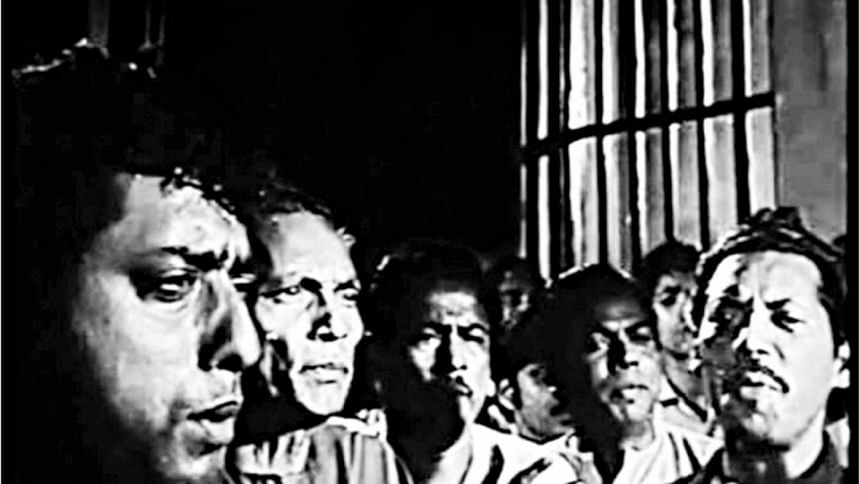Cinema that reflects life

If we examine Bangladeshi films produced thus far since 1971 we would see that most of them are not under the rubric of 'revolutionary cinema' by consciously counteracting the conventions of traditional entertainment films. A film is regarded as revolutionary when it makes a radical departure from conventional films both in terms of content and form. Filmmakers demonstrating a predilection for alternative cinema aesthetics intend to raise the critical consciousness of the spectators instead of immersing them in escapist entertainment. Entertainment-based films are representative of a specific filmmaking genre, but it is erroneous to think that all films must include glamour and glitz. There is no denying that cinema is an art form although in various countries the glut of showy and extravagant films makes cinema synonymous with a business that produces a large profit. If cinema is considered an artistic creation, it is necessary to make sure that films turn out to be aesthetically innovative and socially critical instead of prioritising audience-pleasing elements to maximise profit. One question becomes important at the moment to know the nature of Bangladeshi cinema: Do our films attempt to grapple with urgent social and political issues realistically using unorthodox cinematic techniques, thereby freeing the minds of the spectator from cultural conlonisation?
Satyajit Ray, one of the most-acclaimed Bengali filmmakers, once said: "For the truly serious, socially conscious filmmaker, there can be no prolonged withdrawal into fantasy. He must face the challenge of contemporary reality, examine the facts, probe them, sift them and select from them the material to be transformed into the stuff of cinema." Directors of Bangladeshi mainstream cinema seldom resemble the socially conscious filmmakers referred to by Ray. When mainstream films depict unjust acts committed by the powerful, a larger-than-life hero soon turns up to single-handedly fight the forces of evil and claim victory. Thus, such social criticisms seem harmless in effect. Aping the gaudy conventions generally seen in Bollywood entertainment films such as song-and-dance, attractive male and female leads, romantic relationship, theatricality, villains, violence, happy ending are also commonplace in Bangladeshi mainstream cinema.
Films produced outside the commercial film industry are recognised as cinema of resistance because they reject the ideology of market-driven films. Such alternative films make political statements, either overtly or indirectly, in order to condemn social ills and point the finger at the guilty party. Formal innovation is another important attribute of alternative cinema. A closer look at Bangladeshi feature films of the past few decades shows that only a handful of them qualify as resistance films because of their social critique and innovative form. Contemporary alternative films in Bangladesh are often replete with technical gloss but the use of imaginative and unorthodox cinematic means is a rarity. It is not possible to make an impression with films which use digital technology but remain artistically impoverished. Resistance films do not need to be cerebral or highly experimental but it is important that various images of these films convey socially critical messages. In order to achieve this aim, the camera language and film's narrative must appeal to the reason and intellect of the spectator instead of offering him trivial entertainment.
"Resistance films do not need to be cerebral or highly experimental but it is important that various images of these films convey socially critical messages. In order to achieve this aim, the camera language and film's narrative must appeal to the reason and intellect of the spectator instead of offering him trivial entertainment.
If the viewers are not disturbed by the filmic events, it is unlikely that films' portrayals of social exploitation will enable them to take a stand against all forms of social oppression. Certain Bangladeshi films claiming to be alternative unreasonably highlight themes such as extramarital affairs, sexual activity, the lust of men, thereby causing titillation instead of providing painfully realistic depictions of the actual harsh conditions of contemporary society. Sometimes after showing certain social problems, such films condemn only a hoodlum or a dishonest village headman. But these petty criminals are of course not responsible for the major social and political problems. Such social criticisms thus become futile and they cannot disturb the system which perpetuates injustice.
Films like Jiban Theke Neya (1970) by Zahir Raihan and Matir Moina (2002) by Tareque Masud showed how cinema can be used as an instrument to denounce long-standing political and social problems. Raihan used a metaphorical storyline to provide trenchant political denunciations of an oppressive regime. By setting his allegorical film in the past, Masud courageously criticised ill-effects of religious fundamentalism of contemporary society. Both of these films were banned initially from showing in cinemas, indicating that the governments were disturbed by their contents. By instrumentalising their films to deal with urgent problems, the directors displayed courage and responsibility as socially committed artistes. At the same time, their films rejected conventional cinematic strategies associated with entertainment-based cinema. In Bangladesh, such revolutionary films are rarely produced. On the contrary, the abundance of glitzy elements and puerile humour in contemporary Bangladeshi films and television soap operas demonstrate that attempts are made to rear the spectators on a regular diet of entertainment.
Films avoiding song-and-dance formula but, nonetheless, drawing on glamour attract huge turnouts in cinemas in Bangladesh these days. But such glitzy films prioritising escapist entertainment only bring financial benefit for the producers. They do not help audiences develop a critical consciousness of the actual causes of social injustice. We also need to keep in mind that Bangladeshi films cannot occupy an important position in the realm of world cinema through the constant production of spectacle-like films. Only formally innovative and socially meaningful films will stand out in important international festivals and receive considerable critical attention.
In Bangladesh, the constant media publicity for entertainment-oriented films and the absence of writings and discussions emphasising the importance of socially purposive cinema are turning people into passive consumers of profit-driven films. In 1968, during the student-led revolt against the government in France various scathing slogans were used. One of them still seems highly relevant: "I take part, you take part, he takes part, we take part, you all take part, they profit." If cultural products aim to culturally colonise minds to revel only in entertainment rather than raising a radical consciousness, people will hardly realise the subtle forms of exploitation permeating today's consumerist society. In order to encourage the filmmakers to make decolonising films it is necessary to give them the opportunity to logically criticise social problems. Mrinal Sen, Satyajit Ray and Ritwik Ghatak made their overtly political films during the anti-state Naxalite movement in West Bengal. Their films were not banned by the Indian government. In Bangladesh, can we make sure that socially critical statements in cinema will not be removed by the Censor? If we are to witness the growth of cinema in Bangladesh, it is absolutely imperative that the establishment provides filmmakers with artistic freedom and film scholars and the media help people perceive the importance of socially responsible cinema.
The writer is Professor, Department of Mass Communication and Journalism, University of Dhaka.










Comments